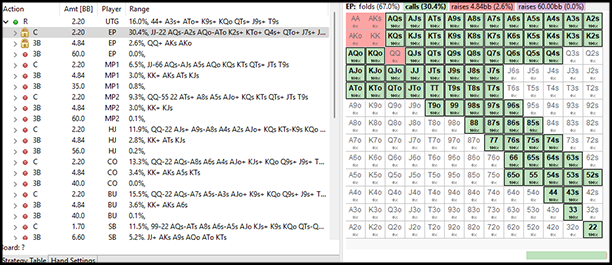- Punishing the Limper
- When to Limp Properly
- Limping Behind in the Small Blind
- Small Blind Complete in a Tournament
- Limping Behind in Late Positon Vs Weaker Players
- Late Position With About 12-18 Big Blinds Effective
- Advanced Limping
- Conclusion
In Texas hold’em poker, limping is defined as entering a pot preflop by calling the big blind. Open limping is when you are the first player to enter the pot, and do so by limping.
For years I’ve criticized limping in no-limit hold’em poker. Limping caps your range, meaning the best hands are not in your range. It fails to take down the blinds. It leaves you out of position in most cases. The solvers recommend some limping, but the strategy is difficult for humans to execute properly.
My usual practice when I observe limping during play is to peg that player as someone who I want to get into as many pots as I can with. In fact in my online play, I color code them green, for ‘go.’

Punishing the Limper
But poker’s always evolving. Limping has always been with us, but I’m starting to see a few decent players using it. These players balance their limping range. I’ve always used a tactic known as “punish the limper,” which is to raise a limper with a big raise and either rob him of his calling chips, or force him to invest more money to play against me with a capped range and usually out of position.
But if you can execute a balanced limping strategy you can punish the punisher, so to speak. Punishing the limper against such a player is risky. In a live $400 tournament I played recently, I was punished twice for all my chips in this manner. One of my limpers had pocket aces. The other had ace-queen suited. Against these players, punishing the limper turned out to be a risky strategy.
Of course, a lot of limpers you encounter still need to be punished. Some of these limpers who you should punish like to trap with ace-king, and sometimes pocket aces or kings. But those hands come up so infrequently you needn’t worry about them.
If you have someone who balances their limps properly, you need to proceed with caution. Your job is to identify who they are.

When to Limp Properly
There are a few, limited situations in which limping is the correct play:
- Limping behind in the small blind
- Small blind complete in a tournament
- Limping behind in late position versus weak players
- Late position with about 12-18 big blinds effective
- Advanced limping
Limping Behind in the Small Blind
When one or more players has limped and you are in the small blind, limping behind can be a profitable play.
Let’s say in a $1/$2 game three players have limped and the action is on you. It only costs you $1 to enter a pot that is up to $9. You are getting 9:1 odds on this call.
With a small pair you have the expressed odds to call hoping for a set. Even with only two limpers in the pot you have 7:1 expressed odds, and it is likely more money will go into this pot. That means you have the implied odds to call hoping to make a set. With a lot of suited connectors you can flop a flush or a straight. You might even flop a full house.
If you don’t flop one of these monsters, you are probably done with the hand. A pair is unlikely to be good enough with all these other players acting behind you, and you will have to play the rest of the hand out of position.
Small Blind Complete in a Tournament
In cash games it’s never a good idea to complete the small blind when there are no limpers in the pot. If the big blind checks his option, you will pay a rake to play out of position with what is likely a marginal hand. If you’re playing a live cash game, it’s a better idea to make a deal with the player on your left to chop the blinds whenever it folds around to you. Of course you can’t make this deal in online cash games.
In a tournament it’s completely different. You’re not paying rake in a tournament. There are likely antes in the pot in addition to the blinds. Even with no limpers in the pot, with antes you’re probably getting about 5:1 pot odds. That means you only need about 17% equity to make this a good call. There are other benefits to this play.
If you complete the small blind and the big blind checks his option, he has the most strongly capped range in hold’em. The big blind should raise with a pretty wide range here, as you have capped your own range and he will be in position for the rest of the hand. That means his raising range is capped out of his check behind range. You can play very aggressively against his heavily capped range.

Another benefit is you can trap a big blind player who aggressively attacks your small blind complete by raising too often. You could complete with a hand like pocket jacks. When he raises to try to steal this pot, you can 3-bet him as a punishment. Because of this play, one could argue for never open raising in the small blind. Just throw all of your small blind hands into one of four buckets:
- Fold and let the big blind take a walk
- Limp-fold
- Limp-call
- Limp-raise
I’m not saying there’s no place for open raising in the small blind. But this simplified small blind limping strategy wouldn’t be a big mistake.
Here is what the Range Trainer Pro solver database recommends as a Game Theory Optimal (GTO) range for the small blind when the action has folded to you with 40bb effective stacks:
Note that you only concede to walk the Big Blind about 18% of the time. You usually complete the small blind. You often raise. Now, you can’t memorize this mixed strategy to a granular level. Your strongest pocket pairs and suited broadways are always raises for value. You always play suited hands with either a limp or a raise. You wouldn’t be making a terrible mistake to use a mixed strategy of about half and half for all of the mixed strategies you see in this table.

Limping Behind in Late Positon Vs Weaker Players
Open limping is a strong indication of a weaker player. So if you’re in late position and multiple players have already limped ahead of you, you can limp behind. Your plan is to aggressively use your positional advantage against them after the flop with a wide range of hands.
Small suited connectors, suited one-gappers, baby pairs, and suited aces and kings with weak kickers make excellent candidates for limping behind against these players.
Since these are weak players, you don’t really need to balance this range with some strong hands. Go ahead and raise with your strong hands. Limpers love to see flops, so someone will likely call.
Late Position With About 12-18 Big Blinds Effective
The solvers recommend some open limps in late position when you get short stacked. If your stack is 15bb a minimum open raise of 2bb represents 13% of your stack. It’s costly if one of the remaining players jams and forces you to fold. A limp cuts this cost in half. Even though you cannot take down the blinds, you will be in position after the flop.
Here is a Range Trainer Pro GTO open range for the button with 15bb:

Note the preponderance of limps in this range. 16% of combos are open limps. The open limps are mixed with 2bb open raises.
Pro Tip: This 15bb button range chart is an important tool in your tournament toolbox. You don’t have to memorize it precisely, but try to keep it in the ballpark. You can make the mixed limp/raise combos 50-50 without costing much equity at all. Situations in late position with your stack depth in the teens come up often. This range contains plays you need to maintain your stack or recover and run deep.
The jams are combos that can generate desired folds, but have decent equity if called. The mixed raises and limps can steal the blinds with the raises and are an affordable way to get into a pot in position.
Advanced Limping
Note: Don’t try to use this play unless you are an advanced player, playing against advanced opponents.
The solver databases don’t recommend limping very much at stack depths of 30bb or above. However, HoldemResources Calculator recommends a surprising amount of limping, even at stack depths of 100bb. I haven’t seen professional level players limp at these extreme stack depths. They know it’s more profitable to build pots by raising instead.
Here is the surprising result of a solution at 100bb stack depths with open limping allowed. I used HRC Pro, which accounts for postflop factors like playing out of position and equity realization. In this simulation there is no rake, and there is a big blind ante:
The under-the-gun range has practically equal limping and raising ranges. These ranges assume that players yet to act do so with game theory optimal (GTO) ranges.
The point of showing you this is not to recommend using this strategy. I recommend you avoid it, at least until you’ve achieved an advanced level of play. But I also recommend that you trust your instincts about the other players at your table.

If you observe someone who’s been playing very well but then they start limping at 30bb effective stacks, they might be executing a balanced strategy. Don’t take their limps as evidence that you need to change your mind about their skill. I may do a blog on advanced limping strategy in the future.
Conclusion
Nearly all of the limpers you encounter at low stakes games do so because they want to see flops for cheap. They think of Texas hold’em like gin rummy; hoping to make sets, straights, and flushes. Avoid limping except for the spots explained above. Go out there and crush the limpers’ weak, capped ranges.
Best of luck to you!

